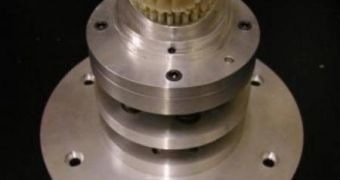In their quests for the best possible materials to implement in new dentures, teeth experts have recently created Dento-Munch, a creepy-looking robot that does nothing else all day except munching. Despite its large grin, owed mostly to the fact that it has no lips, the machine's purpose is actually very complex, offering experts accurate reads of the forces that are exerted over jawbones and artificial teeth, when a person chews with an artificial denture.
The team of experts that created Dento-Munch, based at the University of Bristol, gave their machine a six-degree freedom of movement, which means that the new robot is, at this point in time, one of the most accurate reconstructions of the way we can move our teeth when chewing our food. “We are able to capture real human data – bite force data and motion data – and we feed this data into the chewing robot and then it can do basically the same thing that we do,” UB mechanical engineering postdoctoral student Daniel Raabe explains, quoted by Wired.
At this time, the most widely used materials when it comes to making crowns, bridges and artificial teeth are resins, gold, cements and porcelains, but the problem with them is that, while they may last for a variable amount of time in tests outside the human mouth, the real test is, obviously, inside. In addition to being in a damp place all the time, the new teeth need to withstand constant use, and also to resist bacterial attacks. Our natural teeth have evolved their enamel layer for this job, but until now we've found it difficult to replicate its composition, mostly because we don't know it so well.
With its six actuators, Dento-Munch could be the much-needed solution to the testing problem, in that it could provide a faster way of ensuring that materials scheduled to go into an artificial fixture are not going to disintegrate in a matter of months, leaving the patient in excruciating pains. The thing about the robot is that it also has a reservoir for artificial saliva, whose only purpose is to help with simulating the conditions inside the human oral environment as accurately as possible.

 14 DAY TRIAL //
14 DAY TRIAL //